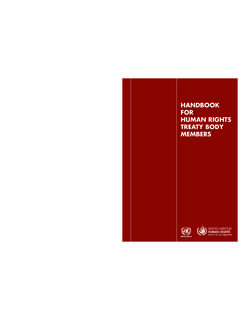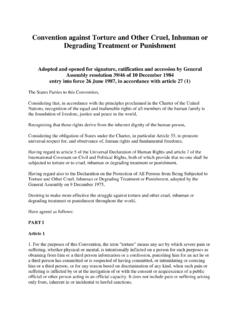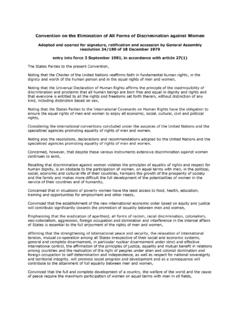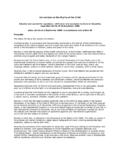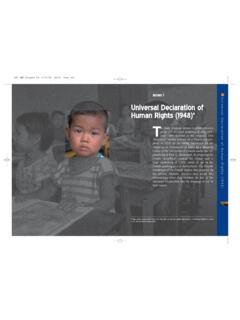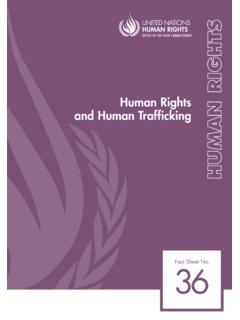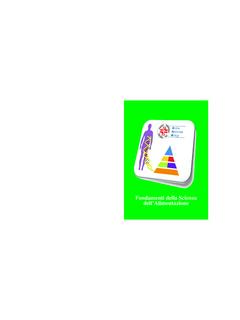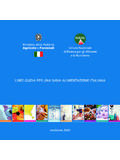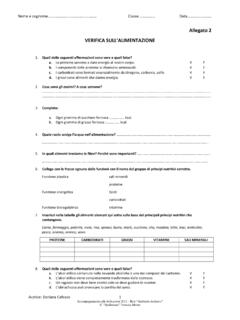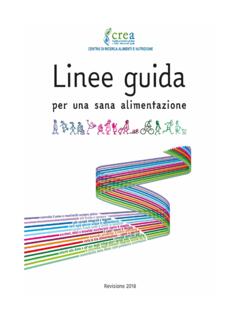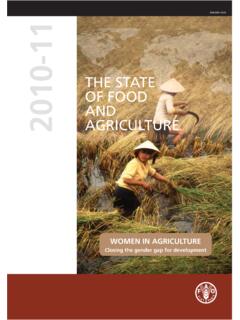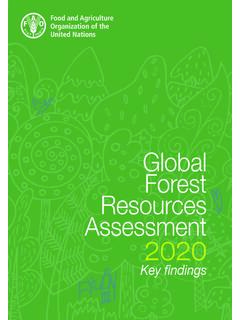Transcription of The Right to Adequate Food - OHCHR | Home
1 R i g h t s R i g h t s UNITED NATIONS. The Right to Adequate Food H u m a n H u m a n Fact Sheet No. 34. The Right to Adequate Food Fact Sheet No. 34. NOTE. The designations employed and the presentation of the material in this publication do not imply the expression of any opinion whatsoever on the part of the Secretariat of the United Nations or the Food and Agriculture Organization of the United Nations concerning the legal status of any country, territory, city or area, or of its authorities, or concerning the delimitation of its frontiers or boundaries. Material contained in this publication may be freely quoted or reprinted, provided credit is given and a copy of the publication containing the reprinted material is sent to the Office of the United Nations High Commissioner for Human Rights, Palais des Nations, 8 14 avenue de la Paix, CH 1211 Geneva 10, Switzerland. ii CONTENTS. Page Abbreviations.. iv Introduction.. 1. I. WHAT IS THE Right TO FOOD? .. 2. A. Key aspects of the Right to food.
2 2. B. Common misconceptions about the Right to food.. 3. C. The link between the Right to food and other human rights .. 5. D. The Right to food in international law.. 7. II. HOW DOES THE Right TO FOOD APPLY TO SPECIFIC GROUPS?.. 9. A. The rural and urban poor.. 10. B. Indigenous peoples.. 12. C. Women .. 14. D. Children.. 16. III. WHAT ARE THE OBLIGATIONS ON STATES. AND THE RESPONSIBILITIES OF OTHERS? ..17. A. Three types of obligations.. 17. B. Progressive and immediate obligations.. 19. C. Obligations with international dimensions .. 22. D. The responsibilities of others.. 23. IV. HOW CAN THE Right TO FOOD BE IMPLEMENTED? .. 26. A. National implementation .. 26. B. Regional and international monitoring and accountability.. 33. Annex.. 44. iii ABBREVIATIONS. AIDS acquired immunodeficiency syndrome FAO Food and Agriculture Organization of the United Nations HIV human immunodeficiency virus ILO International Labour Organization NGO non-governmental organization NHRI national human rights institution OHCHR Office of the United Nations High Commissioner for Human Rights UNICEF United Nations Children's Fund UPR universal periodic review iv INTRODUCTION.
3 According to the Food and Agriculture Organization of the United Nations (FAO), more than one billion people are Over two billion suffer from a lack of essential vitamins and minerals in their food. Nearly six million children die every year from malnutrition or related diseases, that is about half of all preventable deaths. The majority of those suffering from hunger and malnutrition are smallholders or landless people, mostly women and girls living in rural areas without access to productive Although many people might imagine that deaths from hunger generally occur in times of famine and conflict, the fact is that only about 10 per cent of these deaths are the result of armed conflicts, natural catastrophes or exceptional climatic conditions. The other 90 per cent are victims of long-term, chronic lack of access to Adequate food. Combating hunger and malnutrition is more than a moral duty or a policy choice; in many countries, it is a legally binding human rights obligation. The Right to food is recognized in the 1948 Universal Declaration of Human Rights as part of the Right to an Adequate standard of living, and is enshrined in the 1966 International Covenant on Economic, Social and Cultural Rights.
4 It is also protected by regional treaties and national constitutions. Furthermore, the Right to food of specific groups has been recognized in several international conventions. All human beings, regardless of their race, colour, sex, language, religion, political or other opinion, national or social origin, property, birth or other status have the Right to Adequate food and the Right to be free from hunger. At the World Food Summit organized by FAO in 1996, States agreed to halve the number of undernourished people by 2015. They also called for the obligations arising from the Right to food as provided for under international human rights law to be clarified. In response, the Committee on Economic, Social and Social Rights issued its general comment No. 12. (1999), which defines the Right to food. In the United Nations Millennium Declaration, adopted by the General Assembly in 2000, States committed themselves to halving the proportion of people suffering from hunger by 2015. In 2004, FAO adopted the Voluntary Guidelines to Support the Progressive Realization of the Right to Adequate Food in the Context of National Food Security, providing practical guidance to States in their implementation of the Right to Adequate food.
5 This Fact Sheet explains what the Right to Adequate food is, illustrates its implications for specific individuals and groups, and elaborates upon State parties' obligations with respect to this human The Fact Sheet also provides an overview of national, regional and international accountability and monitoring mechanisms. 1. I. WHAT IS THE Right TO FOOD? A. Key aspects of the Right to food The Right to food is an inclusive Right . It is not simply a Right to a minimum ration of calories, proteins and other specific nutrients. It is a Right to all nutritional elements that a person needs to live a healthy and active life, and to the means to access them. The Right to food can be described as follows: The Right to Adequate food is realized when every man, woman and child, alone or in community with others, has physical and economic access at all times to Adequate food or means for its procurement. Committee on Economic, Social and Cultural Rights4. The Right to have regular, permanent and free access, either directly or by means of financial purchases, to quantitatively and qualitatively Adequate and sufficient food corresponding to the cultural traditions of the people to which the consumer belongs, and which ensures a physical and mental, individual and collective, fulfilling and dignified life free of fear.
6 United Nations Special Rapporteur on the Right to food5. It is important to emphasize certain elements of the Right to food. Food must be available, accessible and Adequate :6. Availability requires on the one hand that food should be available . from natural resources either through the production of food, by cultivating land or animal husbandry, or through other ways of obtaining food, such as fishing, hunting or gathering. On the other hand, it means that food should be available for sale in markets and shops. Accessibility requires economic and physical access to food to . be guaranteed. Economic accessibility means that food must be affordable. Individuals should be able to afford food for an Adequate diet without compromising on any other basic needs, such as school fees, medicines or rent. For example, 2. the affordability of food can be guaranteed by ensuring that the minimum wage or social security benefit is sufficient to meet the cost of nutritious food and other basic needs.
7 Physical accessibility means that food should be accessible to all, including to the physically vulnerable, such as children, the sick, persons with disabilities or the elderly, for whom it may be difficult to go out to get food. Access to food must also be guaranteed to people in remote areas and to victims of armed conflicts or natural disasters, as well as to prisoners. For example, to guarantee physical access to food to people living in remote areas the infrastructure could be improved, so that they can reach markets by public transport. Adequacy means that the food must satisfy dietary needs, . taking into account the individual's age, living conditions, health, occupation, sex, etc. For example, if children's food does not contain the nutrients necessary for their physical and mental development, it is not Adequate . Food that is energy-dense and low-nutrient, which can contribute to obesity and other illnesses, could be another example of inadequate food. Food should be safe for human consumption and free from adverse substances, such as contaminants from industrial or agricultural processes, including residues from pesticides, hormones or veterinary drugs.
8 Adequate food should also be culturally acceptable. For example, aid containing food that is religious or cultural taboo for the recipients or inconsistent with their eating habits would not be culturally acceptable. B. Common misconceptions about the Right to food The Right to food is NOT the same as a Right to be fed. Many assume that the Right to food means that Governments have to hand out free food to anyone who needs it. They conclude that this would not be feasible or might cause dependency. This is a misunderstanding. The Right to food is not a Right to be fed, but primarily the Right to feed oneself in dignity. Individuals are expected to meet their own needs, through their own efforts and using their own resources. To be able to do this, a person must live in conditions that allow him or her either to produce food or to buy it. To produce his or her own food, a person needs land, seeds, water and other resources, and to buy it, one needs money and access to the market. The Right to food requires States to provide an enabling environment in which people can use their full poten- 3.
9 Tial to produce or procure Adequate food for themselves and their families. However, when people are not able to feed themselves with their own means, for instance because of an armed conflict, natural disaster or because they are in detention, the State must provide food directly. The denial of the Right to food is NOT a result of a lack of food in the world. One might think that people are denied their Right to food because there is not enough food to go round. However, according to FAO, the world produces enough food to feed its entire population. The root cause of hunger and malnutri- tion is not a lack of food but a lack of access to available food. For example, poverty, social exclusion and discrimination often under- mine people's access to food, not only in developing countries but also in some of the most economically developed countries where there is an abundance of food. In the longer term, however, States also have to make efforts to enable a sustainable production of food to ensure the availability of food for future generations, considering factors such as population growth, impact of possible climate change and the availability of natural resources.
10 The Right to food is different from food security and food sovereignty. These three concepts are different, although there is some overlap. According to FAO, food security exists when all people, at all times, have physical, social and economic access to sufficient, safe and nutritious food that meets their dietary needs and food preferences for an active and healthy life. 7 It is a pre- condition for the full enjoyment of the Right to food. However, the concept of food security itself is not a legal concept per se and does not impose obligations on stakeholders nor does it provide entitlements to them. Food sovereignty is an emerging concept according to which peoples define their own food and own model of food production (such as agriculture and fisheries), determine the extent to which they want to be self-reliant and protect domes- tic food production and regulate trade in order to achieve sustain- able development Food sovereignty is suggested as a concept that promotes an alternative model for agriculture, trade policies and practices that serve people's rights to food and to safe, healthy and ecologically sustainable food production.
